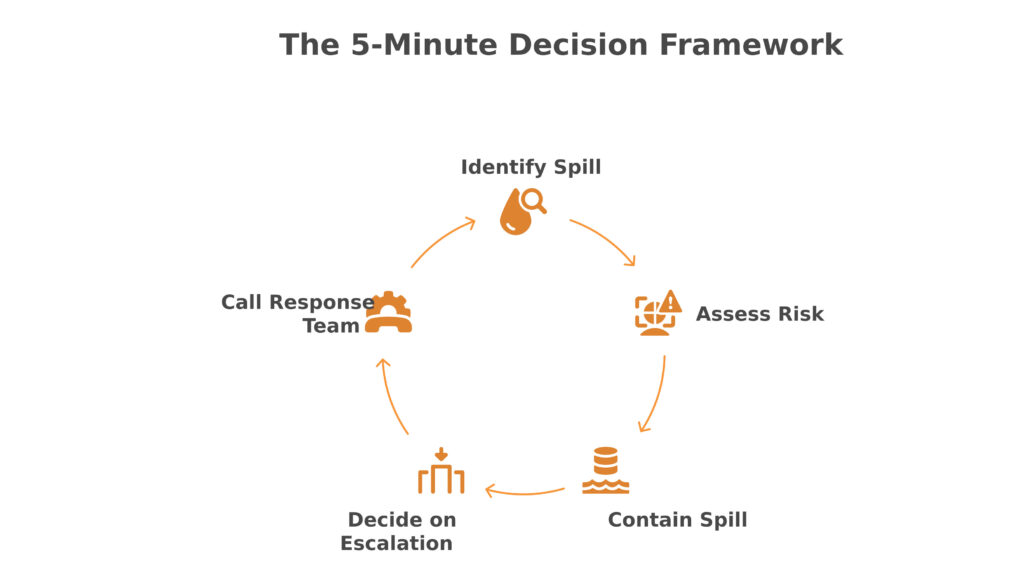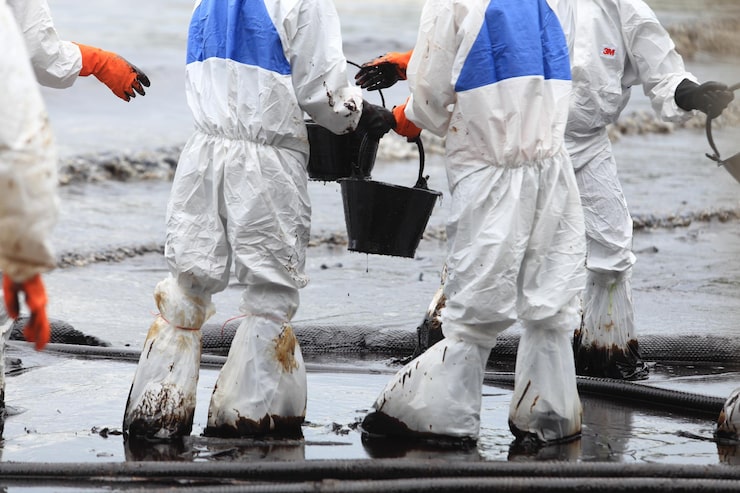Spill response is about systematically controlling, cleaning, and containing a spill. The goal is to reduce harm to people, their property, and the environment. In the case of a spill, immediate mitigation and containment become necessary. Otherwise, hazardous materials can spread to the soil and groundwater.
A response in the first 5 minutes after a spill determines if it will be a minor incident or a major disaster. If you want to know more about when to call a spill response team, then keep reading.
The 5-Minute Decision Framework: Why It Matters
The initial response window is critical for managing a spill incident. Prompt action is needed for containing spills, securing the scene, and addressing safety concerns. This can help prevent immediate risks to the environment and workers.
Delayed response can increase the chances of escalating hazards, environmental damage, and worker injury. It means that the cleanup expenses and regulatory fines will also be high. So, quick decisions and immediate actions to contain hazards are essential.
When talking only about oil spills, there have been 27 major incidents on Australian waters between 1903 and 2012, which introduced around 43,700 tonnes of oil into the ocean, critically endangering marine life. So, addressing spills promptly is important. And here are the steps for determining if you need to call a spill response team.

Step 1: Identify the Spill (Minute 1)
It is important to identify a spill within the first minute of the incident. Here are the questions you can ask yourself.
- What Chemical or Hazard is Spilled?
- How Much of the Hazard is Spilled?
- Where is the Spill Spreading?
The above questions will guide you in determining the risks and the actions necessary. You can use tools like Safety Data Sheets (SDS) and product labelling for identifying substances and their hazards. You will also need detectors, a spill response kit, and other tools and methods to understand the extent of the spill.
Step 2: Assess Risk (Minute 2)
You must assess the risk related to the spill. Try to distinguish between minor and major spills. Evaluate the properties of the spilled substance, like whether it is flammable, toxic, or a biohazard. Also, evaluate the characteristics of the spill, like the size, containment scope, and possibility of uncontrolled spread.
Here is how minor and major spills differ.
| Minor Spill | Major Spill | |
|---|---|---|
| Hazard: |
|
|
| Quantity: |
|
|
| Control: | Easily Controlled | Uncontrolled |
| Examples: |
|
|
| Risks: | Low Risk with Proper Safety Procedures | Injury, Illness, Fire, and Explosion |
| Response: | Managed by Trained Staff | Spill Response Team Needed |
Table 1: Minor vs. Major Spill
Step 3: Contain If Safe (Minute 3)
Your trained staff must take immediate but safe actions to limit the spread of the spill. Safety of the responders must be prioritised. And it must be ensured that the chosen containment actions do not put the responders at risk.
Here are the containment actions and safety measures you can take.
| Containment Actions | Safety Measures |
|---|---|
| Shutting Valves: Trained professionals can safely close leaking valves and stop the flow of spillage. | Personal Protective Equipment (PPE): Make sure you are wearing appropriate PPE like safety glasses and gloves before taking actions. |
| Stopping Leaks: Source of leak must be identified and stopped if that can be done without risk. | Risk Assessment: Evaluate the situation and ensure that your response actions don’t put yourself or others at risk. |
| Using Spill Response Kit: Use booms and absorbents materials for soaking up liquids and creating barriers. | Exposure Prevention: Avoid trying to contain or clean up spills without proper training, and stay at a safe location. |
Table 2: Containment and Safety Actions
Step 4: Decide on Escalation (Minute 4)
Escalation will be necessary and often call for a dedicated spill response team. Professionals are particularly necessary when hazardous substances are involved. The general rule is that if you doubt how you will manage, call the professionals.
You will also need professional responders if the volume of the spill exceeds your in-house containment and cleanup capacity. Calling for professionals will also be necessary if there is a risk of the spill entering waterways or public areas.
When waiting for the spill response team, communicate the hazard incident to others in the area. Try to take some safe measures to prevent the spill from spreading. And make sure you are maintaining a safe distance and notifying others to do the same.
Step 5: Call the Spill Response Team (Minute 5)
You must contact the internal safety department of your organisation to seek guidance and initiate the established spill response protocols of your organisation. You may also need specialised hazardous waste contractors if the spill is significant or of an unusual nature.
If the hazard is severe or poses immediate danger, you should contact emergency services like the hazardous materials teams or the fire department. They can provide immediate assistance and prevent further damage.
Make sure you are communicating clearly with the emergency responders. Mention the type, volume, location, and risks of the spill.
After the Spill Response Team Arrives
Here are the actions you should take after the spill response team arrives.
- Site Handover Process: Formally hand over the authority to work on the site to the response team. Brief the team on the situation and verify if the site is safe for them.
- Documentation and Incident Reporting: Collect and document all relevant data, like photographs, samples, and sensor readings. Create a detailed incident report and fill out all the regulatory documents required as part of compliance.
- Learning Lessons and Planning Prevention: Identify the root cause of the issue and improve strategies for spill containment and prevention. New lessons must be updated in staff training and response plans.
Need A Spill Response Team?
The 5-minute framework can empower staff to make quick and wise decisions on spill response. Controlling, containing, and cleaning up is important to protect human health, property, and the environment.
Spilled materials can be hazardous and uncontrollable. So, it is advisable to request professional assistance. Reach out to a professional spill response team today, and get advice on prevention strategies.
Frequently Asked Questions
Should I Reach Out to Professional Spill Response Teams for Minor Spills?
No, you can contain spills in-house if it is contained, not spreading or posing a risk to the environment and people. If you have the right gear and knowledge, you can manage minor spills even better. But make sure you are reaching out to professionals if you are unsure of the spill’s nature.
What Are the Most Alarming Types of Spills?
Spills of biological agents, chemicals, radioactive waste, flammable materials, and explosive substances are alarming. It is important that only professionals respond to such spills for the safety of the environment and everyone near the site. Specific equipment is also needed for managing the hazards.
How Do I Reach Out to a Professional Spill Response Team in Australia?
You can search online for reputable environmental remediation services in Australia for assistance with spill response. Organisations such as ours have the tools, resources, and expertise to handle contaminants and restore environmental health.
How Do I Maintain My Own Safety as a First Responder to Spill Incidents?
You can keep yourself safe when responding to spill incidents by ensuring that you know the response procedure. Know the use of different equipment, and be aware of their storage location. Make sure you are trained on any action you take, and always have a partner with you when working on remediation.


